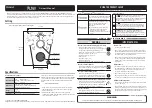
BARTINGTON INSTRUMENTS
Page 8 of 13 OM2808/3
a. Connect a voltmeter to the axis sensor outputs, i.e. across signal X and common.
b. Whilst monitoring the voltmeter readings, align the magnetometer with the
terrestrial field.
c. Confirm the measured readings approach the local geomagnetic field value.
Note:
Geomagnetic field values can be provided by your local magnetic observatory. A
margin of error due to local disturbance should be taken into account.
4.3. Mounting Recommendations
Each magnetometer sensor head and electronics module has a set of mounting holes to allow
attachment to a stable base or fixture. Refer to the mechanical drawings on the product page on
the Bartington Instruments website.
The sensor can also mounted on the Bartington Instruments Mag-TA Tripod Adaptor using the
Mag-TA Product Adaptor mounting plate. See datasheet DS3140 for instructions on how to do
this.
Caution:
Once the sensor head and electronics module have been installed as required,
route the sensor cable so that the minimum bend radius is 75mm (3 inches) in the most
flexible plane (see
). Once in place, secure the cable at
sufficient points along the length of the cable to avoid excessive flexing.
Caution (Mag629):
Take care to align the cable to the connector correctly, to avoid damage
to the connector or magnetometer. When aligned correctly, hand-tighten the connector
collar. Refer to the product brochure for detailed information.
4.4. Installation
1. Site the magnetometer, and install the power supply and cabling.
2. Switch on the power supply and wait until the magnetometer has stabilised.
3. Confirm no magnetic objects are moving in the vicinity.
4. Monitor the sensor outputs.
5. Confirm that the ‘test’ output is high.
6. Confirm that the sum of the measured magnetic field vectors is similar to the expected
local earth field.
Note:
The outputs from the sensor should remain stable to within the quoted noise limits.
Refer to the product brochure for the expected values.































